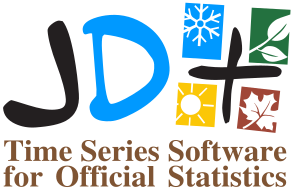Sys.setenv("JAVA_HOME" = ".../jdemetra-standalone-3.x.y-windows-x86_64/nbdemetra/jdk-21.0.2+13-jre")JDemetra+ documentation
What is JDemetra+?
JDemetra+ is an open source software for seasonal adjustment and time series analysis, developed in the framework of Eurostat’s “Centre of Excellence on Statistical Methods and Tools” by the National Bank of Belgium with the support of the Bundesbank and Insee. It has been officially recommended by Eurostat to the members of the European Statistical System since 2015. It is unique in its combination of very fast Java routines, a Graphical User Interface and an ecosystem of R packages (rjdverse). The graphical interface provides structured visual feedback suitable for refined analysis and training. R tools allow the user to combine the capabilities of JDemetra+ with the versatility of the R world, be it for mathematical functions or data wrangling. A pdf version of this documentation is available here
Main Features
JDemetra+ provides algorithms for:
Seasonal Adjustment
Trend estimation
Benchmarking and temporal disaggregation
Nowcasting
Revision analysis
Currently available versions
The highest version currently recommended for production purposes is 2.2.4.
Version 3.x family provides, among other things, extended features for seasonal adjustment and trend estimation, including high frequency data. The latest version 3.2.4 was released on July 11th 2024.
Background
This website is under construction, in the meantime you can fill a large number of the gaps by referring to the previous version of the on-line documentation, coordinated by Sylwia Grudkowska-Kubik (National Bank of Poland).
Eurostat’s recommendations on the statistical processes described in this documentation are outlined in:
Key methodological explanations and state-of-the-art description and references can be found in:

Useful links
To get started, you can browse and watch tutorials for JDemetra+. On this YouTube channel you will also find JDemetra+ related webinars.
If you need user support, please raise an issue in this repository
To keep up with all JDemetra+ related news head over to the JDemetra+ Universe Blog
How to contribute
If you want to help us improve this book, you can fork this repository on GitHub and create pull requests with your contributions.
Installing the software
The sections below detail how to install JDemetra+ (Graphical user interface and Cruncher) and how to configure R to run rjd3 packages.
Graphical User Interface (GUI)
You can find the latest releases
- in the v2.x family: here
As of April 2024, the latest version is v2.2.4
Scroll down the page, download and unzip the file jdemetra-2.2.4-bin.zip.
To start the application, run the file nbdemetra64.exe located in the following subfolder …\jdemetra-2.2.4-bin\nbdemetra\bin
Remark: You can create shortcuts to the executable files if you want to launch them from another folder (Desktop, project folder…).
- in the v3.x family: here
You should install the latest release available denoted from now on v3.x.y
Scroll down the page, download and unzip the file jdemetra-standalone-3.x.y-windows-x86_64.zip, if you use Windows, or the zip corresponding to you OS in the list.
To start the application, run the file nbdemetra64.exe located in the following subfolder …\jdemetra-standalone-3.x.y-windows-x86_64\nbdemetra\bin
Version 3.x requires Java 17 or higher, jdemetra-standalone-3.x.y-windows-x86_64.zip contains a portable version of Java 21, so you don’t have to deal with this issue on your computer.
R packages related to version 3.x (rjd3…) also require Java 17 or higher, you can (and should) use the portable version provided with the graphical user interface to run them, this is explained here.
Additional plugins
To benefit from extended features of the graphical user interface installing additional plug-ins is required. The list of available extensions and the installation procedure are detailed here. How to access the added features in the GUI is described here.
In the v2.x family some of the additional features are:
Benchmarking and Temporal disaggregation Github page
Nowcasting Github page
In the v3.x family some of the additional features are:
Benchmarking and Temporal disaggregation Github page
Seasonal adjustment of high frequency data Github page
Additional algorithms for seasonal adjustment Github page
Cruncher
JDemetra+ has an executable module, called the Cruncher, allowing to automate tasks
To install it :
in v2, go to the JWSACruncher page, download and unzip the compressed folder
jwsacruncher-2.2.4-bin.zip.in v3, go to the jdplus-main page, download and unzip the compressed folder
jwsacruncher-standalone-3.x.y-windows-x86_64.zip.
R packages
JDemetra+ algorithms can be accessed in R, which is detailed here
You can directly head over to this GitHub page, then for each package indications for installation and basic use are provided in the readme files.
Configuration needed to run rjd3 packages
To use rjd3 packages in R, you need Java 17 or higher.
You can (and should) use the version of Java that comes with the Graphical User Interface (GUI). It is contained in the file jdemetra-standalone-3.2.4-windows-x86_64.zip available on this page, in the “Assets” section, which you might have to expand to be able to see all the files.
Once unzipped, the Java will be in located in C:\Software\jdemetra-standalone-3.x.y-windows-x86_64\nbdemetra\jdk-21.0.2+13-jre (path to be adapted to your computer/server): this location must be declared in R.
After unzipping the file:
- run this code at the beginning of your programs
or
declare it “permanently” is the Renviron file (where environment variables specific to
Rare stored), following the steps below:in the R console run
file.edit("~/.Renviron")in the file that opens add the line :
JAVA_HOME= "C:/Software/jdemetra-standalone-3.x.y-windows-x86_64/nbdemetra/jdk-21.0.2+13-jre"- save the file and restart R
Follow R packages installation procedure and run basic examples from the readme files of each package. They are all listed on this page